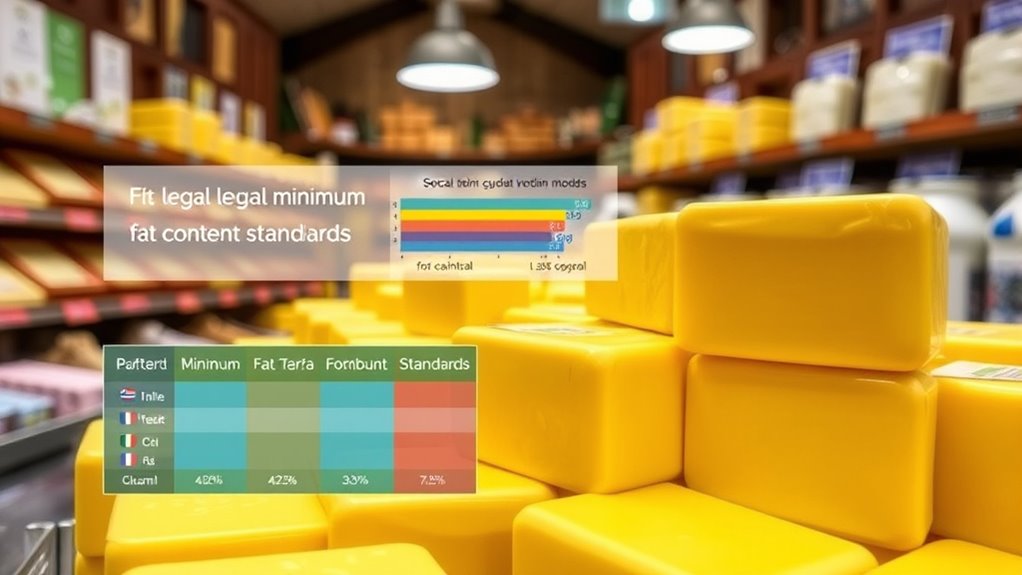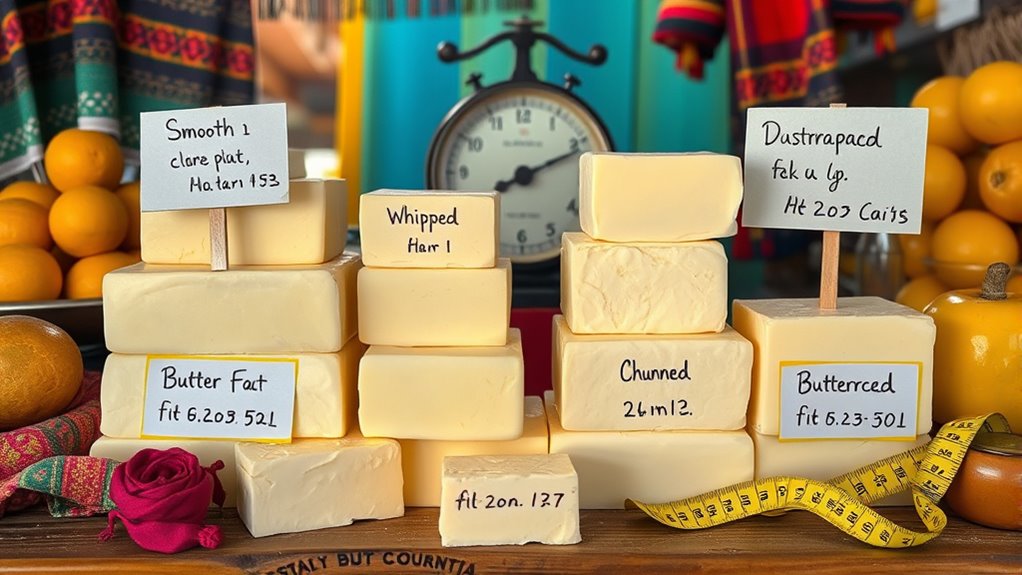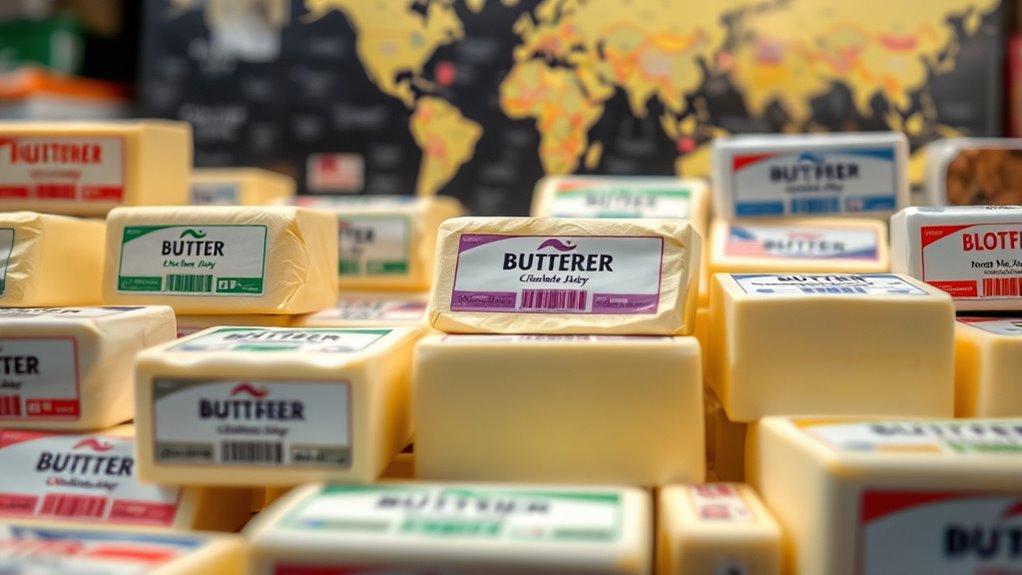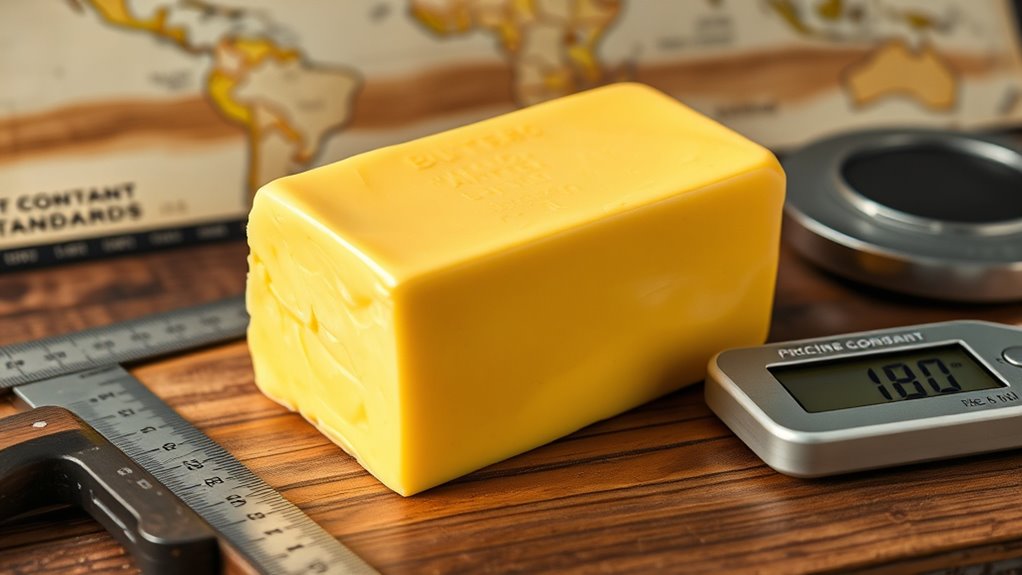Global regulations set minimum fat levels for butter to guarantee authenticity, quality, and safety. In the EU and the US, the minimum is 80%, while Canada also enforces strict labeling standards. Many Asian countries, Australia, and New Zealand maintain similar standards, but Africa and Latin America often have diverse or flexible rules reflecting local practices. These differences impact trade, pricing, and product reputation. To understand how these standards shape the dairy industry worldwide, keep exploring more details.
Key Takeaways
- Most regions, including the EU, US, and Canada, mandate a minimum butterfat content of 80%.
- Regional standards vary, with some Asian and Latin American countries setting different minimums based on local preferences.
- Regulations ensure product authenticity, safety, and consistent quality through strict measurement and labeling requirements.
- Variations in fat standards impact international trade, market access, and export quality.
- Continuous updates and enforcement of standards promote transparency and consumer trust worldwide.
The Definition of Butter and Its Fat Content Requirements

Butter is defined as a dairy product made from the fat and protein components of milk or cream. Its composition primarily consists of milk fats, with a typical fat content ranging between 80% and 82%. This fat content is vital because it determines the butter’s texture, flavor, and quality. Regulations specify minimum fat levels to guarantee consistency and authenticity across markets. The butter composition includes not only fat but also small amounts of water and milk solids, which influence its firmness and melting point. Maintaining a specific fat content is indispensable for meeting legal standards and consumer expectations. Porcelain and ceramic materials are often used in butter storage and processing equipment due to their durability and resistance to contamination. By understanding these requirements, you can better recognize genuine butter and appreciate its role in culinary and nutritional contexts.
European Union Standards for Butter Fat Minimums

Have you ever wondered how the European Union guarantees the quality and authenticity of butter? The EU sets strict standards, including a minimum fat content of 80%, ensuring consistent butter quality across member states. These regulations also emphasize maintaining the butter’s aroma, which is a key indicator of freshness and genuine dairy flavor. Packaging regulations are equally important, requiring clear labeling of fat content and origin to protect consumers and prevent fraud. Proper packaging not only preserves butter’s aroma but also complies with safety and hygiene standards. Additionally, the EU’s unique and wicked planters ensure that packaging materials are eco-friendly and sustainable, supporting environmental responsibility. By enforcing these minimum fat levels and strict packaging rules, the EU helps you trust that the butter you buy is authentic, high-quality, and meets consistent standards across countries.
United States Regulations on Butter Fat Content

In the United States, federal standards set clear minimum requirements for butter’s fat content, but you’ll notice some differences across states. These variations can influence production practices and labeling, so it’s important to understand the specific regulations that apply where you are. Furthermore, private equity trends in the food industry can impact how dairy products like butter are marketed and distributed, shaping the landscape of dairy regulation and innovation. Let’s explore how federal and state laws shape the butter we see in stores today.
Federal Standards for Butter
What exactly are the federal standards that define butter’s composition in the United States? They set the minimum butterfat content at 80%, ensuring quality and consistency. These standards influence everything from butter flavor to packaging regulations, so consumers get a reliable product. You can expect:
- Consistent, rich butter flavor in every stick
- Clear packaging regulations that protect your purchase
- Assurance of pure, high-quality ingredients
- Standardized labeling for transparency
- Confidence in butter’s natural qualities
- Recognizing angel numbers and their meanings can also enhance your understanding of quality indicators in various products.
Variations in State Laws
Are state laws on butter fat content consistent across the United States? Not exactly. While federal standards set a minimum fat level, states have varying regulations that influence butter quality, labeling, and packaging. These differences affect butter shelf life, as some states mandate specific packaging to preserve freshness, while others lack such rules. Butter packaging regulations also vary, impacting how butter is presented and stored locally. Some states require clear labeling about fat content, ensuring consumers know what they’re buying, while others are less strict. These variations can lead to confusion and inconsistency in butter quality across the country. As a result, producers often need to adapt their packaging and storage methods to meet state-specific rules, which influences overall butter distribution and consumer experience. Additionally, regulatory compliance requirements can impact the production process and cost for manufacturers operating in different states.
Canadian Standards on Butter Composition and Labeling

In Canada, butter must meet specific legal fat minimums to guarantee quality and consistency. Labels must clearly display information about fat content and other standards, so you can make informed choices. These regulations help maintain high quality and transparency in the butter you buy.
Legal Fat Minimums
Canadian standards set clear minimum fat content levels for butter to guarantee product consistency and quality. These legal fat minimums ensure every batch delivers that rich butter flavor you expect, while maintaining accurate fat measurement. By adhering to these standards, producers protect consumers from subpar products and uphold trust in Canadian dairy. Knowing these rules can inspire confidence when choosing butter, knowing it meets strict quality benchmarks. Additionally, these standards help maintain the resale value of butter products by preserving their reputation for quality.
- Feel reassured that your butter has the authentic flavor you love
- Trust that every package meets precise fat measurement standards
- Experience consistent quality with each purchase
- Enjoy peace of mind knowing standards prevent inferior products
- Celebrate the dedication to excellence in Canadian dairy practices
Labeling Requirements
Proper labeling guarantees consumers can make informed choices about butter. In Canada, regulations require clear nutritional labeling, detailing fat content, ingredients, and allergens. This enhances consumer awareness and helps you compare products easily. The labels must include standardized information such as total fat, saturated fat, and trans fats, ensuring transparency. To understand these requirements better, consider this table:
| Label Component | Purpose |
|---|---|
| Nutritional Info | Helps assess fat levels and nutritional value |
| Ingredients List | Shows components, including added fats or additives |
| Allergens | Alerts you to possible allergenic ingredients |
| Expiry Date | Ensures freshness and safety |
A comprehensive understanding of fat composition aids consumers in making healthier dietary choices.
Quality Standards
To guarantee butter meets safety and quality expectations, Canadian standards specify strict guidelines for its composition and labeling. These standards ensure the butter’s origin is clear and authentic, and that flavor profiles stay consistent. You can trust that every package reflects the highest quality, with precise fat content and minimal additives. When choosing Canadian butter, you’re selecting a product that upholds rigorous quality benchmarks.
- Feel confident about its pure butter origin, free from misleading claims
- Enjoy rich, authentic flavor profiles that showcase natural butter qualities
- Experience consistent texture and appearance in every batch
- Rely on clear labels indicating fat content and ingredients
- Know the product adheres to strict safety and quality regulations
- These quality standards also help prevent fraud and ensure transparency in the marketplace.
These standards protect your health and satisfy your taste buds, giving you peace of mind with every purchase.
Asian Countries and Their Legal Fat Standards for Butter

Asian countries have established diverse legal standards for the fat content in butter, reflecting both regional preferences and regulatory priorities. These standards influence butter processing methods, ensuring products meet specific fat minimums. Countries like Japan and India set strict legal minimums, often requiring a certain percentage of butterfat to guarantee quality and consistency. To enforce these standards, authorities utilize various fat measurement techniques, such as the Gerber method or near-infrared spectroscopy, which provide accurate assessments of butter’s fat content. These techniques allow regulators to verify compliance efficiently during production and import checks. By standardizing fat content through clear legal minimums, Asian countries aim to balance consumer expectations with industry practices, fostering trust and maintaining product integrity across markets. Additionally, growth mindset among regulators encourages continuous improvement in measurement accuracy and enforcement strategies to adapt to evolving industry standards.
Australian and New Zealand Regulations on Butter Fat Levels

Australian and New Zealand regulations set clear standards for butter fat levels to guarantee product quality and consumer confidence. These rules ensure that each batch delivers the authentic butter flavor you expect, reflecting the skill of local dairy farming. When regulations are met, you can trust that your butter is rich, consistent, and safe.
You’ll feel assured knowing:
- The butter’s flavor is genuine and satisfying
- Dairy farmers uphold high standards in their craft
- The product’s quality is carefully regulated
- You’re enjoying a product that supports local dairy communities
- Your choice promotes sustainable, responsible farming practices
- The fat content of the butter is precisely controlled to meet legal minimums
These standards protect your health and enhance your appreciation for quality butter, reinforcing the importance of strict fat level regulations in Australia and New Zealand.
Latin American Countries and Their Approaches to Butter Standardization

In Latin American countries, butter standardization varies widely, reflecting diverse regulatory approaches and local dairy practices. Some nations set strict minimum fat content standards aligned with international norms, ensuring consistency in dairy production. Others adopt more flexible regulations that accommodate traditional methods and regional consumer preferences. For example, countries like Argentina and Brazil focus on standardizing butter to meet export standards, emphasizing quality and safety. Meanwhile, local consumer preferences influence the permitted fat levels, with some markets favoring creamier, higher-fat butters and others accepting lower-fat options. These differences often stem from dairy production methods and cultural tastes, leading to a patchwork of standards across the region. Overall, Latin American countries balance regulatory requirements with consumer demands, shaping their unique approaches to butter standardization.
Variations in Butter Fat Standards Among African Nations

Across African nations, butter fat standards vary markedly, shaped by local agricultural practices, cultural preferences, and regulatory frameworks. These differences reflect deep-rooted traditional practices and community values that influence how butter is produced and consumed. You might find some countries setting lower minimum fat content to preserve traditional textures, while others prioritize higher standards for export quality.
Consider these points:
- Cultural preferences often dictate the preferred texture and richness of butter.
- Traditional practices influence the fat content used in artisanal production.
- Local climate impacts the methods of butter processing.
- Regulatory frameworks adapt to regional agricultural realities.
- Variations foster a rich diversity of butter types across Africa.
Understanding these differences helps appreciate how culture and tradition shape butter standards across the continent.
How International Trade Is Affected by Differing Fat Minimums

Differing minimum fat content standards can substantially impact international trade by creating barriers and complicating market access. When countries set varying fat minimums, exporters face trade tariffs and import restrictions that limit their ability to sell butter abroad. These differences force producers to modify formulations or face rejection, increasing costs. For example, countries with higher minimum fat standards may block imports from nations with lower standards. This table illustrates how standards vary:
| Country | Minimum Fat Content | Trade Implication |
|---|---|---|
| Country A | 80% | Restricted imports |
| Country B | 82% | Reduced market access |
| Country C | 78% | Possible rejection |
Such discrepancies hinder free trade, raising costs and reducing market competition.
Frequently Asked Questions
How Do Fat Standards Impact Butter Pricing Globally?
You might notice that fat standards influence butter pricing globally by shaping supply and demand. These standards create economic implications, as producers must meet regulatory compliance, which can affect production costs. Higher minimum fat content can increase prices, while lower standards may make butter more affordable. Ultimately, these regulations help guarantee quality but also impact market dynamics, influencing what consumers pay and how producers strategize their pricing.
Are There Health Benefits Linked to Higher or Lower Fat Content?
Imagine butter as a golden sun, its fat percentage shining with health potential. Higher fat content may offer more energy and essential nutrients, benefiting your body, while lower fat could reduce calorie intake and cholesterol. The health implications depend on your dietary needs. Choosing butter with the right fat percentage aligns with your wellness goals, making it a symbol of balance between indulgence and health-conscious living.
How Do Traditional Butter Recipes Influence Legal Fat Minimums?
Traditional recipes and cultural influences play a significant role in shaping legal fat minimums for butter. You’ll notice that these recipes often reflect regional tastes and practices, which influence regulations to preserve cultural authenticity. Laws aim to balance traditional standards with modern nutritional guidelines, ensuring that butter remains true to its cultural roots while meeting health and safety standards. This interplay helps maintain diverse culinary heritages worldwide.
What Are the Challenges for Producers Exporting Butter Internationally?
You face challenges in exporting butter internationally due to strict export compliance and quality assurance standards. Different countries have varying legal minimums for fat content, making it difficult to meet all regulations. Ensuring your product consistently meets these standards requires rigorous testing and documentation. You must adapt your processes for each market, which can increase costs and complexity, but maintaining quality and compliance is essential for successful global trade.
How Do Consumer Preferences Shape Fat Content Regulations?
Did you know that over 60% of consumers prefer butter with specific fat levels? Your preferences heavily influence regulations, as producers aim to meet consumer demand for healthier options or richer flavors. Fat preferences drive legislative decisions, ensuring products align with taste expectations and health concerns. By understanding your desires, authorities set standards that balance tradition, health, and market trends, shaping the butter you enjoy daily.
Conclusion
Think of butter standards worldwide as a tapestry woven with different threads. Each country adds its unique hue, shaping the flavor of international trade. By understanding these varied fat minimums, you become the skilled weaver, ensuring your products meet diverse expectations. Embrace this global mosaic, and you’ll navigate the dairy world with confidence, turning potential knots into seamless connections. After all, mastery lies in appreciating each thread’s place in the bigger picture.










